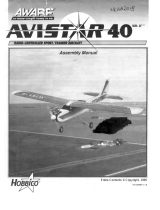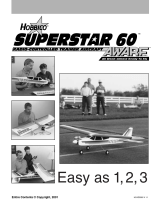Page is loading ...

Version 1.5
2010
© Kennedy Composites
7/4/2010
ELF Assembly

7/4/2010
ELF Assembly Instructions [1] Dfriant
What is the ELF?
The ELF is a 1-meter wingspan discus launch glider (DLG)
The ELF allows the Pilot to fly in small spaces like never before
The ELF combines state-of-the-art model sailplane design and
construction technology coupled with simplicity at a low cost
The ELF is intended for pilots of all skill levels and experience
The ELF is big fun in a small package!
Ready to fly at 3.4 ounces
(NOTE: Flying weight is based on a number of factors. Not all planes will weigh 3.4 oz.)

7/4/2010
ELF Assembly Instructions [2] Dfriant
Table of Contents
ELF Parts and Materials List
P. 3
10 Step Assembly Procedure
P. 4
1) Cement the Fuselage Pod to the Boom
P. 4
2) Install the V-tail Control Horns & Cement the V-tails Halves Together
P. 5
3) Cement the V-tail onto the Boom
P. 6
4) Install the Pushrods on the Boom
P. 7
5) Install the Pushrods, Pushrod Tips, and Connect the Pushrods to the V-tail
P. 8
6) Install the Servos and the Battery and Connect the Pushrods to the Servos
P. 9
7) Install the Receiver and Connect the Servos and Battery to the Receiver
P. 10
8) Install the DLG Pegs in both Ends of the Wing
P. 11
9) Install the Nose-Pod, Install the Wing, and Balance the CG
P. 12
10) Program the Transmitter and Set the V-tail Control Throw Limits
P. 13
Go FLY!

5/14/2010
ELF Parts and Materials List
The ELF kit includes the following parts:
1) 1 - Wing
2) 2 - V-tail Stabilizer halves
3) 1 - Fuselage boom
4) 1 - Fuselage Wing mount pod
5) 1 - Fuselage nose-pod
6) 2 - V-tail pushrods
7) 2 - V-tail pushrod horns
8) 4 - V-tail pushrod tips
9) 4 - Wing mount screws (2 extra)
10) 2 - DLG Wing launch pegs
List of materials needed to assemble the ELF:
Medium-thick foam-safe CA glue
150-grit Sandpaper
Masking Tape
Wax Paper
Needle-nose pliers
Razor knife
List of radio equipment needed to fly the ELF:
240MaH LiPo Battery Pack (Shown)
(available from Kennedy Composites)
2 Micro-Servos
Micro-Receiver (Spektrum AR6250)
Radio transmitter
battery
Charge plug

7/4/2010
ELF Assembly Instructions [4] Dfriant
ELF Assembly Procedure – READ ENTIRE INSTRUCTIONS BEFORE BEGINNING
STEP 1: Cement the Fuselage Pod to the Boom
1
2
3
4
5
6
7
8
9
Sand carbon boom
smooth with 150 grit
sandpaper
Carbon boom sanded smooth
CA Wing mount
pod to carbon
fuselage boom
(3 places)
Pod glued in 3 places
Side view of pod
Close up side view of pod
Shows nose-pod installed temporarily
Glue pod to boom
Glue pod to boom
NOTE: Nose-pod is installed later in the assembly
NOTE: Allow CA to cure without kicker
1
2
3

7/4/2010
ELF Assembly Instructions [5] Dfriant
STEP 2: Install the V-tail Control Horns and Cement the V-tail halves Together
1
2
3
4
5
6
7
8
9
Mark location for v-tail control horns
Cut slot for horn in v-tail
Horn placed in slot
Slot cut in v-tail
Glue horn in place
Both horns glued in place with CA
Tape v-tail halves together temporarily
and glue together with CA as shown below
Glue v-tail
halves
together
with CA
Bend v-tail to 106 degrees and
hold in place with tape until
CA cures. Do not use kicker.
Remove tape when cured.
106 deg.
template

7/4/2010
ELF Assembly Instructions [6] Dfriant
STEP 3: Cement the V-tail onto the Boom
1
2
6
Temporarily install the Wing w/ 2 bolts
Turn
Wing over
and lay
Stab on
boom to
test fit
Tape Stab
to table
until CA
cures
5
Position Stab over
CA at end of boom
Placing Stab and Wing upside
down automatically aligns them
parallel to each other
3
Remove
Stab and
apply CA
to end of
Boom to
glue Stab
in place
4
CA
applied to
end of
Boom
7
8
9
Turn
plane
over
and CA
both
sides
of
Boom
CA
both
sides
of
boom
on top
of stab
Stab glued in place. Allow CA
to cure. Do not use kicker

7/4/2010
ELF Assembly Instructions [7] Dfriant
STEP 4: Install the Pushrods on the Boom
1
2
6
5
3
4
7
8
9
Cut 10 3/8” long pieces of Teflon
tubing to make pushrod guides
Place 5 pieces evenly
spaced on each side
of Boom as shown
Run a piece of thin music wire along
the side of the boom and space the
5 pieces of tubing along the wire
Place a drop of CA top and
bottom on each piece of
Teflon tube with a toothpick
Teflon tubing evenly
spaced along Boom
Pull music wire when CA is cured
Teflon tubing glued in place
along Boom in 5 places
Teflon tubing glued in place
along Boom in 5 places
Teflon tubing glued in place
along Boom in 5 places
Tubing placed in 5
places along Boom
1
2
3
4
5
Music wire
taped in place

7/4/2010
ELF Assembly Instructions [8] Dfriant
STEP 5: Install the Pushrods, Pushrod Tips, and Connect the Pushrods to the V-tail
Install the carbon pushrods
Pushrods fit through holes in pod
Pushrods fit through Teflon
tubes glued on boom
Pushrods fit through Teflon
tubes glued on boom
Pushrods extend past
the end of the v-tail
Bend pushrod tips 90 deg. and
slide on end of pushrods
CA tip to pushrod
Crimp tip on pushrod
with pliers
Install tips on
v-tail horns
Fit through hole in pod
Fit through Hole in pod
Under bridge
Under bridge

7/4/2010
ELF Assembly Instructions [9] Dfriant
STEP 6: Install the Servos and the Battery and Connect the Pushrods to the Servos
1
2
6
5
3
4
7
8
2) Center the servos; install
pushrod tips on the servos;
place servos on the boom
Position v-tail surfaces to neutral
and cut pushrods to length
Rudder pushrod
Elevator pushrod
Crimp pushrod tips onto pushrods
Place pushrod into pushrod tip
1) Z-bend the end of pushrod tips
Glue bottom of servos and all sides
of servos to the boom with CA
Glue battery to boom with CA
Battery alarm
Glue battery alarm to boom with CA
Battery and servos installed

7/4/2010
ELF Assembly Instructions [10] Dfriant
STEP 7: Install the Receiver and Connect the Battery and Servos to the Receiver
1
2
6
5
3
4
7
The receiver is installed
between the Wing bolt mounts
Receiver
Wing bolt mounts
Wing bolt mounts
Receiver installed
Elevator and rudder servos and
battery connected to receiver
Electronic system fully installed.
Servo/battery wires run under bridge
Nose-pod shown in place over
servos and battery
Close up photo of the nose-pod in
place over servos and battery
Antenna positioned under bridge

7/4/2010
ELF Assembly Instructions [11] Dfriant
STEP 8: Install the DLG Pegs in both Ends of the Wing
1
2
6
5
3
4
8
7
DLG peg fits into
slot on ends of Wing
Fitting DLG peg into
slot on end of Wing
Apply CA to the inside of the slot
Peg fits
flat on the
end of the
Wing
Apply CA as required to
secure the peg in place
Peg installed on left Wing tip
Peg installed on right Wing tip
Ready to assemble plane

7/4/2010
ELF Assembly Instructions [12] Dfriant
STEP 9: Install the Nose-Pod, Install the Wing, and Balance the CG
1
2
6
5
3
4
7
Fit the nose-pod over the front
of the boom up to and around
the leading edge of the Wing
Turn the Elf over and fit the nose-
pod over the Wing mount pod
Tape the top of the nose-pod to
the Wing to secure it in place
CG balance stand
Place plane on CG
stand at 3” behind
Wing leading edge at
the root
CG located 3” behind
Wing leading edge
Balanced and
ready to fly

7/4/2010
ELF Assembly Instructions [13] Dfriant
STEP 10: Program the Transmitter and Set the V-tail Control Throws
Set up your Elf using the V-tail configuration for your transmitter. See your transmitter manual for instructions.
V-tail movement for left and right turns and differential to initiate flat turns is depicted below.
For the first test flights the Elevator and Rudder Control throws should travel 3/8” up.
For the first few test flights toss your Elf straight ahead of you using an overhand throw to check the elevator and
rudder settings. Make adjustments as needed.
After you are confident that the elevator and rudder are set satisfactorily you can begin discus launching your Elf.
Make adjustments to control throws as desired to suit your personal preferences.

If you have further questions or would like to purchase additional products please contact us at:
Kennedy Composites
1935 Highvalley Trail
Grand Prarie, TX 75052
Phone: 972-602-3144
Email: [email protected]
www.kennedycomposites.com
Credits
Copyright © Barry Kennedy
Some Photos & Illustrations: Vladimir Gavrilko
Design / Layout / Instructions / Photographs: Dave Friant
/




